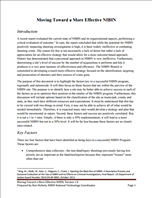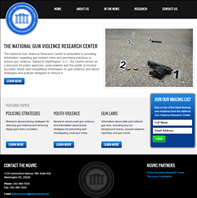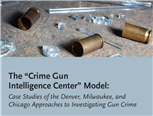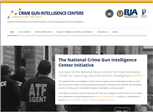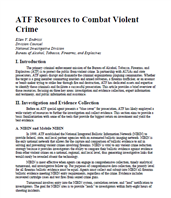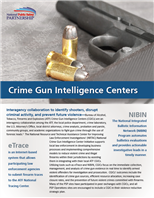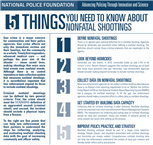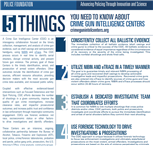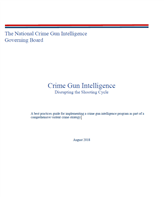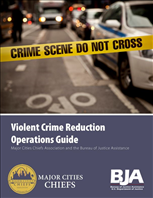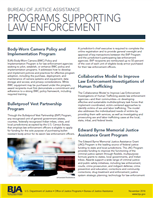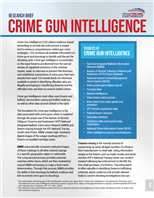Moving Toward a More Effective NIBIN
The purpose of this document is to highlight the factors key to a successful NIBIN program, regionally and nationwide. It will then focus on those factors that are within the purview of the NIBIN site.
National Gun Violence Research Center
The National Gun Violence Research Center is dedicated to providing information regarding gun-related crime and promising practices to reduce gun violence. Based in Washington, D.C., the Center serves as a resource for police agencies, policymakers and the public to receive accurate, timely and nonpartisan information on gun violence and about strategies and policies designed to reduce it.
NIBIN Frequently Asked Questions
Frequently Asked Questions regarding ATF's National Integrated Ballistics Information Network
Denver's Crime Gun Intelligence Center
This film is about a unique collaboration of federal and local law enforcement and prosecutors in Denver which targets both those who commit gun crimes and those who illegally sell the weapons used in the crimes. This film is for informational or educational purposes only.
Denver Crime Gun Task Force
A unique law enforcement collaboration in Denver targeting gun crimes by using real-time forensic ballistic information to tie crimes together to help reduce violent crime.
ATF Training Resources
ATF regularly presents training for Special Agents at various locations across the country, and the training sessions typically include space for attendance by officers from other Federal, State, and local law enforcement agencies. Agencies can contact their local ATF office to determine scheduling and availability. Topics include: Basic Undercover Operations, Advanced Undercover Operations, Rural Tactical Operations, Social Media, Cell Phone Exploitation, Firearms Trafficking and FFL Burglaries, Gang-Related RICO Investigations, and Officer Safety and Armed Individuals.
The "Crime Gun Intelligence Center" Model
Case studies of the Denver, Milwaukee, and Chicago approaches to Investigating Gun Crime
The National Crime Gun Intelligence Center Initiative
The National Crime Gun Intelligence Center Initiative supports local multidisciplinary teams in their efforts to prevent violent crime by identifying perpetrators, linking criminal activities, and identifying sources of crime guns for immediate disruption, investigation, and prosecution. These efforts and others are all components of Crime Gun Intelligence Centers (CGICs), an innovative and collaborative concept developed by the Denver Police Department and the U.S. Department of Justice’s Bureau of Alcohol, Tobacco, Firearms and Explosives (ATF).
ATF Resources to Combat Violent Crime
The primary criminal enforcement mission of the Bureau of Alcohol, Tobacco, Firearms, and Explosives (ATF) is to protect the public from violent crime. In partnership with AUSAs and state prosecutors, ATF agents disrupt and dismantle the criminal organizations plaguing communities. Whether the target is a gang member committing murders and armed robberies, a firearms trafficker, or an arsonist or bomb maker trying to strike fear through fire and destruction, ATF has dedicated assets and expertise to identify those criminals and facilitate a successful prosecution. This article provides a brief overview of those resources, focusing on three key areas: investigation and evidence collection, expert information and testimony, and public information and assistance.
Crime Gun Intelligence Centers Guide
This document provides background on CGIC processes and includes a peer exchange sample guide and additional resources. Agencies interested in learning more about CGICs may find it helpful to visit an agency with an established program in a peer learning opportunity.
5 Things You Need to Know About Nonfatal Shootings
This one page fact sheet provides five key points that can help law enforcement and their partners to understand the steps for collecting, analyzing, and evaluating nonfatal shooting data with the goal of increasing community and officer safety.
5 Things You Need to Know About Crime Gun Intelligence Centers
This one page fact sheet provides five key areas that CGICs should implement to enhance effectiveness and improve outcomes.
Crime Gun Intelligence: Disrupting the Shooting Cycle
A best practices guide for implementing a crime gun intelligence program as part of a comprehensive violent crime strategy.
Violent Crime Reduction Operations Guide (VCROG)
While some communities suffer much more than others, violent crime is a daunting challenge for metropolitan Chiefs and Sheriffs. Starting from their first day on the job and for every day they serve. This guide is written by Chiefs and for Chiefs. As a living document, we hope it will be updated and enhanced with best practices in the years ahead. It is the tradition of Major Cities Chiefs to share lessons learned with each other. The Violent Crime Reduction Operations Guide was developed in this spirit because it seeks to convey what works and why when facing the menace of violent crime in urban areas.
Minimum Required Operating Standards for National Integrated Ballistic Information Network (NIBIN) Sites
A summary of the minimum required operating standards for National Integrated Ballistic Information Network (NIBIN) sites, effective July 2018.
BJA's Programs Supporting Law Enforcement
BJA's programs available to support law enforcement
PSP Research Brief: Crime Gun Intelligence
Crime Gun Intelligence (CGI) utilizes evidence-based technology to provide law enforcement a unique tool to enhance comprehensive violent gun crime strategies. CGI combines all available information on crime guns and shootings to identify and disrupt the shooting cycle. CGI reveals leads not otherwise available to assist in identifying offenders who are illegally purchasing or transferring firearms and the offenders who use them to commit violent crimes. This document reviews the past 15 years of research on these strategies from the leading experts in the field. Also included are additional sources of information and guidance on CGICs and crime gun intelligence.
PSP Webinar: Crime Guns 101
The initial recovery and identification of a crime gun is one of the most critical steps in any investigation. This step is even more critical for agencies whose communities are experiencing high incidences of violent gun crime, are expanding their utilization of crime gun intelligence (National Integrated Ballistic Information Network [NIBIN] and the Bureau of Alcohol, Tobacco, Firearms and Explosives’ [ATF] eTrace), or are participating in a Crime Gun Intelligence Center (CGIC). These firearms provide valuable investigative leads and are subsequently scrutinized during all aspects of the investigation that follows the recovery. Despite the importance of this initial step, few officers receive training on the identification of firearms and, as a result, firearms are frequently misidentified, leading to missed opportunities for lead development, case connection, and successful prosecution. This webinar provided an overview of the NIBIN process and CGIC concept, history and relevance of ATF’s eTrace, how to properly identify and recover crime guns, and lessons learned and successes from unique cases.
